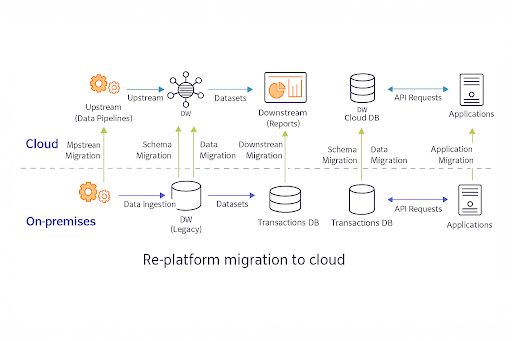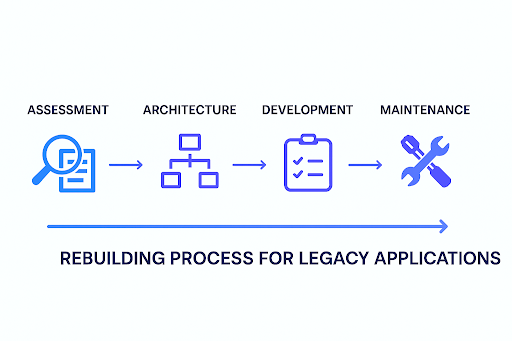Table of content
Many companies schedule their legacy modernization every two to three years simply because they have to. If not doing so, they face ballooning maintenance costs, mounting technical debt, and missed integration opportunities. The timely system upgrade saves money and effort for future business achievements.
This article will guide you through two proven legacy modernization strategies and help you decide which path aligns best with your business goals, budget, and risk tolerance. Let’s begin your digital transformation success now.
What’s the Difference between Replatforming and Rebuilding?
Replatforming and rebuilding were not the first-line choice earlier. Businesses have traditionally opted for the lift-and-shift legacy modernization strategy. Although it’s straightforward and comprehensive, the lift-and-shift approach ignored the fundamental inefficiency, scalability, and integration issues.
That’s why holistic modernization is now represented by 2 major approaches: replatforming and rebuilding. Here’s a brief comparison of these legacy modernization strategies before we delve into the peculiarities.
| Replatforming | Rebuilding | |
| Estimated Cost | around 50% of a full rebuild | 100%+ |
| Timeline | Up to several months | Up to a year |
| Risk Level | Moderate | High |
| Customization | Limited | Unlimited |
| Technical Debt Addressed | Partial | Complete |
| User Experience Impact | Minimal | Significant |
To help you understand how and why these approaches frequently strike the right balance for many companies, we’ll go into further detail on both of them one by one.
Replatforming: What Is It and When to Choose?
“Replatforming. Migrate an application component to a new runtime platform. Make minimal changes to code to adapt to the new platform, but don’t change the code structure or the features and functions it provides.” – Gartner.
As said above, replatforming involves moving your current application to a new, contemporary platform. Usually, companies migrate to the cloud from on-premises or to a more efficient and modern cloud service provider. By moving systems and applications while replatforming, developers slightly adjust the code and configuration for new services and infrastructure. However, they don’t refactor the application or system code meticulously.
That’s why replatforming legacy modernization strategy is the “sweet spot” for businesses that:
- Need a Quicker ROI: With minimal interference, you go live on a safe, scalable platform in a matter of weeks as opposed to months.
- Value Familiar Interfaces: Your teams and users enjoy the same interfaces and workflows.
- Minimize Disruption: You don’t need to stop activities while you modernize.
To sum up, replatforming is a good option if your core program is still reliable, you have a tight budget and schedule, and you want the benefits of modern functionality without completely rebuilding. It’s the practical decision to prolong the life of your legacy systems, reduce operating expenses, and minimize maintenance workload. Want to learn more about how to replatform? Our legacy replatforming guide will show you the roadmap from A to Z.
How to Cut Costs with Replatforming
Replatforming is one of the most budget-friendly strategies of legacy modernization, but with these cost-cutting techniques, you can get even more at a reasonable price:
- Lift-and-Shift first, then Refactor: Expedite the migration process and mitigate reworking with “lift-and-shift” tools. Only after stabilizing the new platform do you optimize solutions.
- Optimize Cloud Pricing: For baseline workloads, contract pay-as-you-go tariffs. For consistent services, subscribe on a yearly (or longer) basis to receive discounts of up to 60%.
- Protect Your Assets: Monitor usage and optimize the size of large virtual machines, containers, or databases.
- Use Managed Services: Transfer database, caching, and messaging functions to PaaS solutions (e.g., RDS, Azure SQL, Cloud Memorystore). Reduce operational staff and licensing fees for self-hosted middleware.
- Use Native Migration Resources: Built-in tools (Azure Migrate, AWS Database Migration Service) reduce consultation costs and human labor. Little scripting will automate data replication and schema migration.
- Reduce Storage Expenses: Store rarely visited data in cold storage tiers (like Azure Cool Blob and S3 Glacier). To move items automatically, enable lifecycle policies.
- Automate Infrastructure as Code and CI/CD (including AI-powered automation): To avoid expensive configuration drift, define your infrastructure in code (Terraform, ARM templates).
- Use Current Integrations: To prevent re-engineering downstream integrations, maintain consistent micro-service endpoints and API contracts during the migration.
- Apply Continuous Cost Monitoring: Include cost dashboards and notifications in your DevOps workflows (AWS Cost Explorer, Azure Cost Management). To ensure accountability, assign resource tags and divide money among teams, projects, or environments.
These replatforming best practices will help you maintain a healthy bottom line while providing high impact. But what’s with rebuilding?
Rebuilding: What Is It and When to Choose?
“Rebuild. Rebuild or rewrite the application component from scratch while preserving its scope and specifications.” – Gartner.
Rebuilding, as one of the legacy system modernization strategies, means that you take your old software and remake it into a brand-new program from scratch with serverless or microservices architectures. In the process, you completely rethink the foundations: user experience, business logic, and data models to meet present and future requirements.
The key benefits of rebuilding are obvious and numerous, including:
- tech debt removal,
- serverless, containerized, or full-cloud deployment,
- the unlimited scaling and integration options,
- codebase refactoring, and so on.
So, if your legacy system is barely functioning and covers intolerable risks, which is no longer aligned with your corporate goals, rebuilding is the only option.
How to Cut Costs when Rebuilding?
Although rebuilding your app from the ground up is the most expensive method among legacy application modernization strategies. Yet, you can control costs while producing a solid, future-proof solution with these best practices:
- Use the Strangler Fig Design: Replace outdated components with new microservices one at a time. Defer less important features for later stages.
- Create a Minimum Viable Product (MVP): Validate assumptions on fundamental business workflows. Opt for “must-have” features instead of “nice-to-have” ones.
- Use Open-Source Libraries and Frameworks: Use community-maintained, tried-and-true tools like Node.js, .NET Core, and Spring Boot as much as you can, fine-tuning them when needed.
- Adopt Managed Cloud-Native Services: Shift database, caching, and messaging to PaaS solutions (such as Amazon RDS, Azure Cache). Pay only for the use.
- Early Containerization: Docker/Kubernetes package services standardize environments and reduce new engineer onboarding time.
- Automate CI/CD and Testing: Invest in automated performance, integration, and unit testing to identify regressions early and prevent costly rework. Reduce infrastructure maintenance with cloud-based pipelines (GitHub Actions, GitLab CI).
- Use DevOps and Agile Best Practices: To avoid expensive last-minute adjustments, divide development into brief, time-boxed sprints with ongoing demo and feedback loops.
- Contract Out Non-Core Tasks: Collaborate with reliable offshore or nearshore teams for general components.
- Track and Optimize Your Cloud Spending: Monitor resource usage and right-size instances continuously. Put auto-shutdown in place for non-production settings.
You may turn a monolithic codebase into a contemporary, modular system without going over budget, which will guarantee that your legacy system modernization reaches the highest possible return on investment.
Legacy Modernization Trends and Strategies: Step-by-Step Guide
Use this step-by-step guide to tailor a legacy modernization strategy that fits your specific business objectives before you get into the details.
- Assess Current System State: Explore inventory applications, dependencies, and technical debt. Evaluate performance, security, and user feedback for analysis.
- Define Objectives: What is your main goal? Cost reduction? Time-to-market? Feature expansion? Get it written down with specifics.
- Select Approach: Use our article to decide between replatforming or rebuilding legacy modernization strategies.
- Engage Stakeholders: Sync up with the operations, security, and business teams.
- Plan and Architect: Establish the migration path, target state architecture, and risk reduction.
- Execute in Phases: Expand after validating small modules.
- Monitor & Iterate: Use DevOps pipelines for continuous improvement.
With your staged plan in place, you can now go over the key elements and choose the strategy that will help you achieve your goals.
A Final Word
Knowing these important differences helps you match your legacy modernization plan to your company’s risk tolerance, available resources, and long-term digital goals, ensuring that you select the course that will yield both short-term gains and long-term expansion.
Whichever route you decide on, Devox Software is ready to assist in the most grandiose legacy modernization plan. Schedule a call to discuss.
Frequently Asked Questions
-
What is the best legacy modernization strategy for small businesses?
Replatforming frequently helps small teams because it’s less expensive and promises a quicker return on investment.
-
How do I measure success after modernizing a legacy system?
Monitor key performance indicators (KPIs) such as total cost of ownership (TCO), mean time to recovery (MTTR), deployment frequency, and user satisfaction. They help you keep your finger on the pulse of the project.
-
Can I mix both replatforming and rebuilding?
Yes, combining rebuilding and replatforming during a migration or modernization project is possible and often beneficial. While rebuilding entails major code changes and sometimes a complete rewrite, replatforming concentrates on migrating programs to a new platform with little to no code modifications. By combining these tactics, you optimize various application portfolio components according to their criticality, complexity, and modernization objectives.
-
How can I be sure my migration is secure?
Encryption, access controls, and data validation should be your priorities to ensure security throughout the migration. To protect your data while it’s in transit and at rest, repeat the steps before, during, and after the transfer process.














